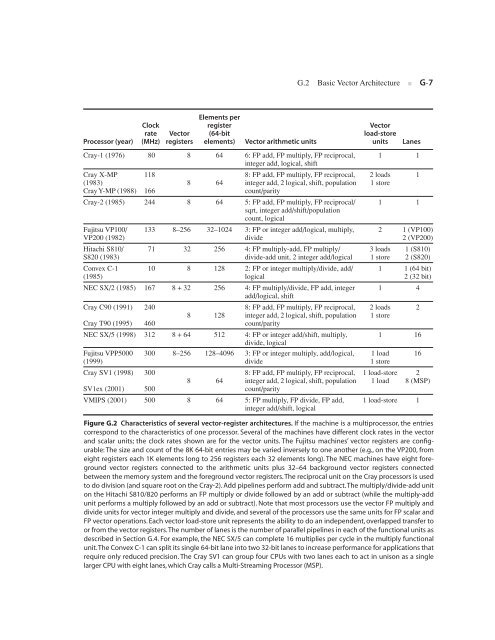Appendix G - Clemson University
Appendix G - Clemson University
Appendix G - Clemson University
Create successful ePaper yourself
Turn your PDF publications into a flip-book with our unique Google optimized e-Paper software.
Processor (year)<br />
Clock<br />
rate<br />
(MHz)<br />
Vector<br />
registers<br />
Elements per<br />
register<br />
(64-bit<br />
elements) Vector arithmetic units<br />
G.2 Basic Vector Architecture<br />
Cray-1 (1976) 80 8 64 6: FP add, FP multiply, FP reciprocal,<br />
integer add, logical, shift<br />
Cray X-MP<br />
(1983)<br />
Cray Y-MP (1988)<br />
118<br />
166<br />
8 64<br />
8: FP add, FP multiply, FP reciprocal,<br />
integer add, 2 logical, shift, population<br />
count/parity<br />
Cray-2 (1985) 244 8 64 5: FP add, FP multiply, FP reciprocal/<br />
sqrt, integer add/shift/population<br />
count, logical<br />
Fujitsu VP100/<br />
VP200 (1982)<br />
Hitachi S810/<br />
S820 (1983)<br />
Convex C-1<br />
(1985)<br />
133 8–256 32–1024 3: FP or integer add/logical, multiply,<br />
divide<br />
71 32 256 4: FP multiply-add, FP multiply/<br />
divide-add unit, 2 integer add/logical<br />
10 8 128 2: FP or integer multiply/divide, add/<br />
logical<br />
NEC SX/2 (1985) 167 8 + 32 256 4: FP multiply/divide, FP add, integer<br />
add/logical, shift<br />
Cray C90 (1991)<br />
Cray T90 (1995)<br />
240<br />
460<br />
8 128<br />
8: FP add, FP multiply, FP reciprocal,<br />
integer add, 2 logical, shift, population<br />
count/parity<br />
NEC SX/5 (1998) 312 8 + 64 512 4: FP or integer add/shift, multiply,<br />
divide, logical<br />
Fujitsu VPP5000<br />
(1999)<br />
Cray SV1 (1998)<br />
SV1ex (2001)<br />
300 8–256 128–4096 3: FP or integer multiply, add/logical,<br />
divide<br />
300<br />
500<br />
8 64<br />
8: FP add, FP multiply, FP reciprocal,<br />
integer add, 2 logical, shift, population<br />
count/parity<br />
VMIPS (2001) 500 8 64 5: FP multiply, FP divide, FP add,<br />
integer add/shift, logical<br />
■<br />
Vector<br />
load-store<br />
units Lanes<br />
1 1<br />
2 loads<br />
1 store<br />
1<br />
1 1<br />
G-7<br />
2 1 (VP100)<br />
2 (VP200)<br />
3 loads<br />
1 store<br />
1 (S810)<br />
2 (S820)<br />
1 1 (64 bit)<br />
2 (32 bit)<br />
1 4<br />
2 loads<br />
1 store<br />
2<br />
1 16<br />
1 load<br />
1 store<br />
1 load-store<br />
1 load<br />
16<br />
2<br />
8 (MSP)<br />
1 load-store 1<br />
Figure G.2 Characteristics of several vector-register architectures. If the machine is a multiprocessor, the entries<br />
correspond to the characteristics of one processor. Several of the machines have different clock rates in the vector<br />
and scalar units; the clock rates shown are for the vector units. The Fujitsu machines’ vector registers are configurable:<br />
The size and count of the 8K 64-bit entries may be varied inversely to one another (e.g., on the VP200, from<br />
eight registers each 1K elements long to 256 registers each 32 elements long). The NEC machines have eight foreground<br />
vector registers connected to the arithmetic units plus 32–64 background vector registers connected<br />
between the memory system and the foreground vector registers. The reciprocal unit on the Cray processors is used<br />
to do division (and square root on the Cray-2). Add pipelines perform add and subtract. The multiply/divide-add unit<br />
on the Hitachi S810/820 performs an FP multiply or divide followed by an add or subtract (while the multiply-add<br />
unit performs a multiply followed by an add or subtract). Note that most processors use the vector FP multiply and<br />
divide units for vector integer multiply and divide, and several of the processors use the same units for FP scalar and<br />
FP vector operations. Each vector load-store unit represents the ability to do an independent, overlapped transfer to<br />
or from the vector registers. The number of lanes is the number of parallel pipelines in each of the functional units as<br />
described in Section G.4. For example, the NEC SX/5 can complete 16 multiplies per cycle in the multiply functional<br />
unit. The Convex C-1 can split its single 64-bit lane into two 32-bit lanes to increase performance for applications that<br />
require only reduced precision. The Cray SV1 can group four CPUs with two lanes each to act in unison as a single<br />
larger CPU with eight lanes, which Cray calls a Multi-Streaming Processor (MSP).

















